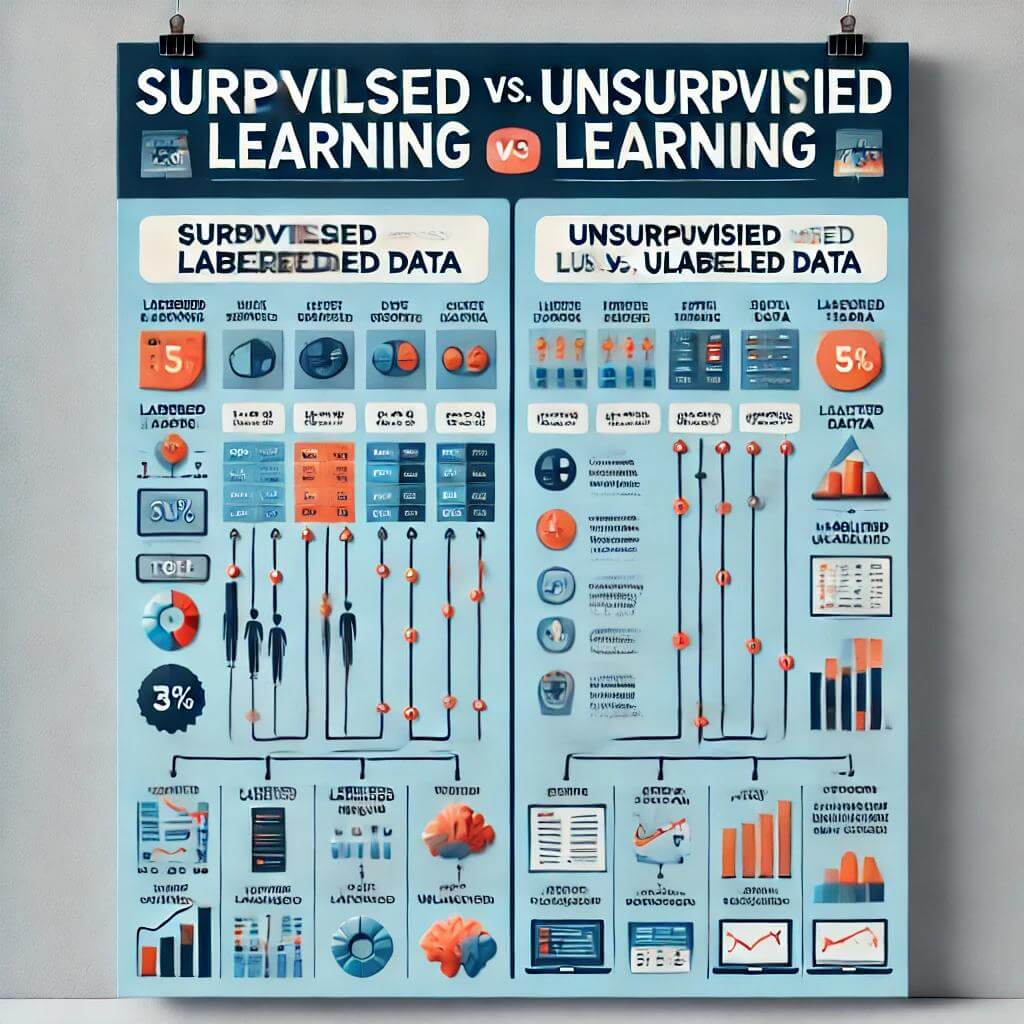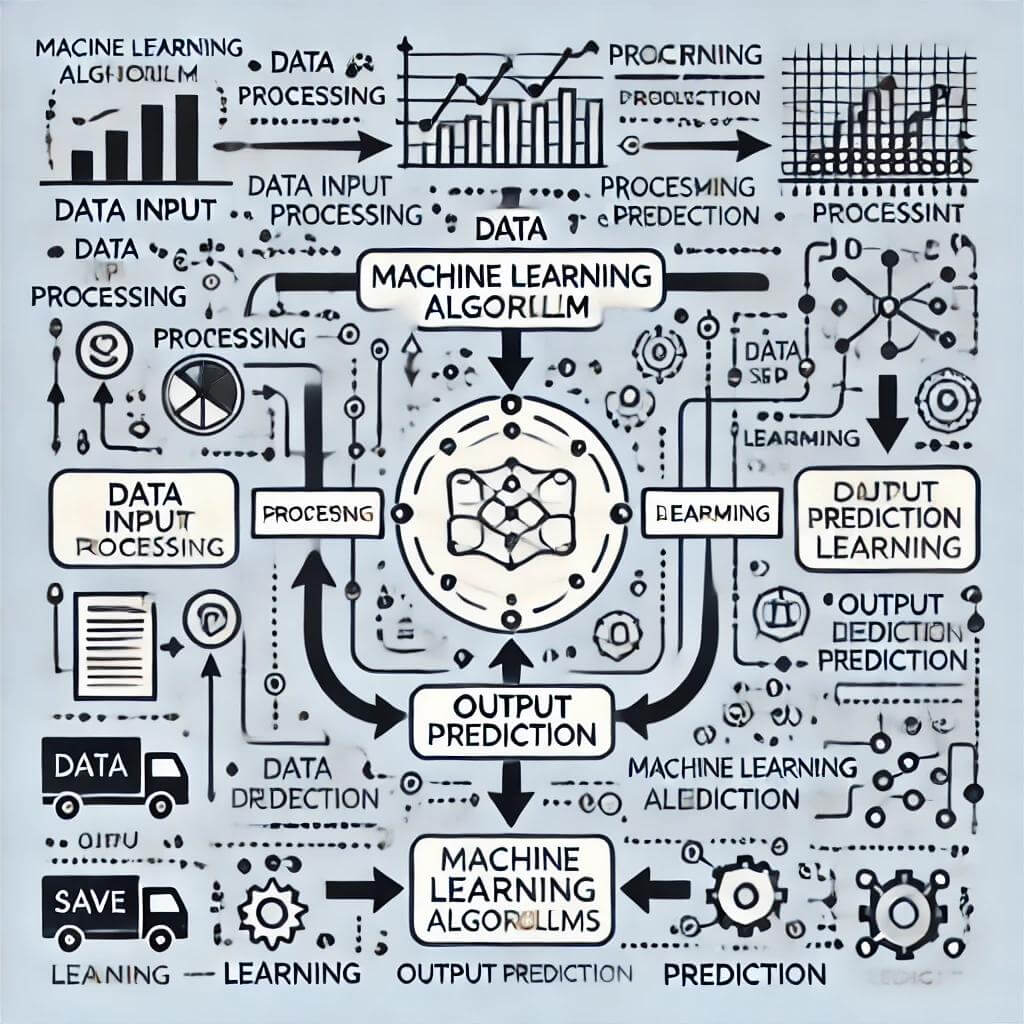Supervised vs. Unsupervised Learning
In the world of machine learning, there are two major types of learning methods: supervised and unsupervised learning. Understanding the differences between these two approaches is critical, as each plays a distinct role in how machines process data and make decisions.
In this article, I’ll explain how these learning methods differ, the types of problems they solve, and provide real-world examples to help illustrate how they’re used.
What is Supervised Learning?
Supervised learning is like teaching a child to recognize objects by showing them images and telling them what each image is. You guide the model with labeled data—essentially giving it both the input (the image) and the correct answer (the label, like “cat” or “dog”). The model then learns to map the input to the output.
How Supervised Learning Works
In supervised learning, the machine is trained using labeled datasets, meaning each input comes with the correct output. The goal is to make accurate predictions when given new, unseen data.
For instance, imagine you have a dataset of houses with information such as the square footage, the number of bedrooms, and the selling price. If you want to predict the price of a new house based on its size and features, you would use a supervised learning algorithm to find a pattern between the features (input) and the price (output).
Types of Supervised Learning
Supervised learning can be divided into two main types:
- Classification: When the output is a category (e.g., is this email spam or not?).
- Regression: When the output is a continuous value (e.g., predicting housing prices).
Code Example: Supervised Learning (Python)
from sklearn.datasets import load_boston
from sklearn.model_selection import train_test_split
from sklearn.linear_model import LinearRegression
# Load dataset
data = load_boston()
X = data.data
y = data.target
# Split into training and testing sets
X_train, X_test, y_train, y_test = train_test_split(X, y, test_size=0.2)
# Train model
model = LinearRegression()
model.fit(X_train, y_train)
# Predict on new data
predictions = model.predict(X_test)
print(predictions)
In this example, we use linear regression, a common supervised learning algorithm, to predict housing prices based on features like square footage and location.
What is Unsupervised Learning?
Unsupervised learning is like giving a child a puzzle but not telling them what the final picture should look like. The machine is left to explore the data on its own, finding patterns and relationships without guidance or labeled data.
How Unsupervised Learning Works
In unsupervised learning, the machine works with data that doesn’t have any labels. The goal here is not to predict a specific output but to find hidden patterns or group similar data points together.
For example, if you have customer data from an online store, unsupervised learning could help identify clusters of customers with similar purchasing habits. These groups can be used for targeted marketing campaigns without needing explicit labels for the customer categories.
Types of Unsupervised Learning
- Clustering: Grouping data points into clusters based on their similarities (e.g., K-means clustering).
- Dimensionality Reduction: Reducing the complexity of datasets by decreasing the number of features while keeping important information intact (e.g., Principal Component Analysis).
Code Example: Unsupervised Learning (Python)
from sklearn.cluster import KMeans
import numpy as np
# Generate random data
data = np.random.rand(100, 3)
# Apply K-Means clustering
kmeans = KMeans(n_clusters=3)
kmeans.fit(data)
# Get cluster predictions
clusters = kmeans.predict(data)
print(clusters)
In this example, we use K-means clustering, an unsupervised learning technique, to group data points into clusters based on their similarities.
Key Differences Between Supervised and Unsupervised Learning
Although both supervised and unsupervised learning are powerful, they serve different purposes.
Supervised vs. Unsupervised Learning
| Characteristic | Supervised Learning | Unsupervised Learning |
|---|---|---|
| Data | Uses labeled data | Uses unlabeled data |
| Goal | Predict a specific output | Discover hidden patterns in the data |
| Tasks | Classification and regression | Clustering and dimensionality reduction |
| Training Process | Learns from input-output pairs | Learns by exploring relationships in the data |
| Real-World Examples | Spam detection, image recognition | Customer segmentation, anomaly detection |
Applications of Supervised Learning
Supervised learning is often used when you have clear goals and labeled data, and you want to make predictions or classifications. Some common applications include:
Spam Detection
Many email services use supervised learning algorithms to classify emails as spam or not. The model is trained on labeled data (spam or not spam), and over time it learns to recognize patterns in spam emails.
Medical Diagnosis
In healthcare, supervised learning is used to train models that can diagnose diseases based on patient data, such as symptoms or medical history. The labeled data helps the model identify which patients are at risk for specific conditions.
Customer Churn Prediction
Businesses use supervised learning to predict whether a customer is likely to stop using their service (churn) based on their past interactions and behavior.
Applications of Unsupervised Learning
Unsupervised learning shines when there are no labels and the goal is to find hidden patterns. It’s especially useful in exploratory data analysis and discovery tasks.
Customer Segmentation
Unsupervised learning helps companies segment their customers based on purchasing behavior or demographics. By grouping customers with similar patterns, businesses can create more effective marketing strategies.
Anomaly Detection
In industries like finance, unsupervised learning algorithms are used to detect unusual behavior, such as fraudulent transactions. By learning what “normal” looks like, the model can flag outliers that may indicate fraud.
Market Basket Analysis
Retailers use unsupervised learning to identify patterns in customer purchases, helping them to recommend products or bundle items together based on shopping habits.
Challenges in Supervised and Unsupervised Learning
Both methods have their own challenges:
Supervised Learning Challenges
- Labeling Data: It can be time-consuming and expensive to label large datasets.
- Overfitting: If a model learns too well from the training data, it may not perform well on new, unseen data.
Unsupervised Learning Challenges
- No Clear Output: Without labeled data, it can be difficult to evaluate how well the model is performing.
- Complexity: Finding meaningful patterns in large datasets without guidance can be computationally expensive and challenging.
Conclusion
Both supervised and unsupervised learning have their strengths and are suited for different types of tasks. Supervised learning is the go-to method when you have labeled data and a clear prediction task, while unsupervised learning is ideal for discovering hidden structures in the data. Understanding these differences can help you choose the right approach for your specific machine learning problem.




Post Comment